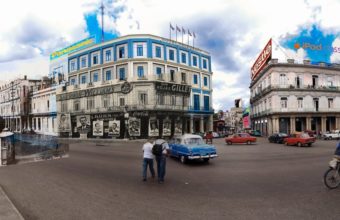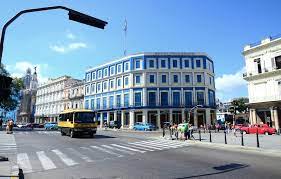LA ESQUINA DE PRADO Y NEPTUNO, LA HABANA, CUBA, EL CORAZÒN MUSICAL DE TODA UNA ÉPOCA. PHOTOS/VIDEOS
Si hay un lugar en la capital cubana con genuina fama universal, ese es la esquina de las calles Prado y Neptuno. Este reconocimiento se debe a una canción de Enrique Jorrín, “La Engañadora”, la primera canción del género cha-cha-cha, reconocida por todos los especialistas, grabada por la Orquesta América en 1953.
El Cha Cha Chá es un agradable y rítmico género que se canta y baila, descendiente del tradicional danzón. El músico utilizó un coro con las voces de los músicos de la orquesta, porque según dijo lograba “que se oyera con claridad la letra de los temas musicales y permitía disimular la calidad de las voces que en realidad eran músicos, no cantantes”. El singular nombre se debe al sonido que producen los zapatos al rozar el piso en de momento de bailar las parejas.
 VIDEOS- Enrique Jorrin en “La Engañadora”..
VIDEOS- Enrique Jorrin en “La Engañadora”..
En ese momento, Enrique Jorrín era violinista y luego director musical de la importante agrupación cubana, al mismo tiempo que componía gran parte de su repertorio. “La engañadora” se convirtió inmediatamente en el sencillo más vendido de la discográfica cubana Panart, para iniciar desde allí su vuelo al mundo de la fama, convirtiéndose en una de las canciones cubanas más influyentes.
El chachachá se impuso en el gusto de los cubanos y pronto puso a bailar a los latinoamericanos. Muchos fueron los nombres de este cadencioso ritmo que ocuparon los primeros lugares en el gusto popular.
Por ejemplo, “ La Engañadora” , de Enrique Jorrín, interpretada por la orquesta América, nació en un salón de baile que existía en la esquina de Prado y Neptuno en La Habana. Se dice que Jorrín se había inspirado en el hermoso cuerpo de una niña en el salón de baile local, sus “pechos y glúteos” algo común en la época como lo son hoy los implantes de silicona.
A Prado y Neptuno
Iba una chiquita
Que todos los hombres
La tenían que mirar ..
De esta manera, las calles de Prado y Neptuno, la Habana fue donde el canto y el propio cha-cha-cha se pusieron de moda.
LA CREACIÒN DEL CHA CHA CHA…
 VIDEOS- Historia Musical del Cha Cha Chá…
VIDEOS- Historia Musical del Cha Cha Chá…
Lo cierto es que el músico se había dado cuenta de que el mambo era difícil de bailar en salas y discotecas debido a la sincopa de su ritmo, y entonces decidió crear un nuevo ritmo con un baile fantástico. El nombre “cha-cha-cha” en realidad vino del coro de la canción “Silver Star”, que apareció en la cara B del single, y que también fue un éxito rotundo. Jorrín compuso, éxito tras éxito hasta convertirse en un verdadero mito de la música cubana.
El cha-cha-chá en cambio, creció y hasta tal punto que en la lejana China se convirtió en el ritmo más conocido.
Otras orquestas lograron universalizar el chachachá como “La Aragón”, “Fajardo y sus Estrellas”, “Sensación” y en New York “Tito” Puente, Ray Cohen, se enamoraron también de este cubanísimo ritmo.
Según muchos especialistas, una canción con este peculiar ritmo es la base del rock and roll de los años 50 y 60 del siglo pasado. El célebre crítico musical John Wilson proclamó en esos años: “Cha-cha-cha es el rey”.
Así, 1953 marcó un hito en la música cubana y “La Engañadora” marcó para siempre a Prado y Neptuno como el corazón musical de toda una época.
THE CORNER OF PRADO AND NEPTUNO, LA HAVANA, CUBA, THE MUSICAL HEART OF AN ALL-TIME. PHOTOS / VIDEOS
If there is a place in the Cuban capital with genuine universal fame, that is the corner of Prado and Neptuno streets. This recognition is due to a song by Enrique Jorrín, “La Engañadora”, the first song of the cha-cha-cha genre, recognized by all specialists, recorded by the Orquesta América in 1953.
The Cha Cha Chá is a pleasant and rhythmic genre that is sung and danced, a descendant of the traditional danzón. The musician used a chorus with the voices of the musicians of the orchestra because according to him he said he achieved “that the lyrics of the musical themes were heard clearly and allowed to hide the quality of the voices that were actually musicians, not singers”. The unique name is due to the sound that the shoes make when they touch the floor when couples dance.
At that time, Enrique Jorrín was a violinist and later musical director of the important Cuban group, at the same time that he composed a large part of its repertoire. “La deceñadora” immediately became the best-selling single on the Cuban record label Panart, starting from there its flight to the world of fame, becoming one of the most influential Cuban songs.
 VIDEOS- Musical History of Cha Cha Cha…
VIDEOS- Musical History of Cha Cha Cha…
The cha-cha was imposed on the taste of the Cubans and soon made the Latin Americans dance. Many were the names of this lilting rhythm that occupied the first places in popular taste.
For example, “La Engañadora”, by Enrique Jorrín, performed by the América orchestra, was born in a dance hall that existed on the corner of Prado and Neptuno in Havana. It is said that Jorrín had been inspired by the beautiful body of a girl in the local dance hall, her “breasts and buttocks” something common at the time as silicone implants are today.
To Prado and Neptune
A little girl was going
That all men
They had to look at her.
In this way, the streets of Prado and Neptuno, Havana was where singing and cha-cha-cha itself became fashionable.
THE CREATION OF CHA CHA CHÁ …
The truth is that the musician had realized that the mambo was difficult to dance in rooms and clubs due to the syncopation of his rhythm, and then he decided to create a new rhythm with a fantastic dance. The name “cha-cha-cha” actually came from the chorus of the song “Silver Star”, which appeared on the B-side of the single, and was also a smash hit. Jorrín composed, success after success until he became a true myth of Cuban music.
The cha-cha-chá, on the other hand, grew and to such an extent that in distant China it became the best-known rhythm.
Other orchestras managed to universalize the cha-cha, such as “La Aragón”, “Fajardo y la Estrellas de él”, “Sensation” and in New York “Tito” Puente, Ray Cohen, also fell in love with this very Cuban rhythm.
According to many specialists, a song with this peculiar rhythm is the basis of rock and roll from the 50s and 60s of the last century. The famous music critic John Wilson proclaimed in those years: “Cha-cha-cha is the king.”
Thus, 1953 marked a milestone in Cuban music and “La Engañadora” forever marked Prado and Neptuno as the musical heart of an entire era.
Agencies/ CadenaHabana/ Odalys Padilla/ Enciclopedia/ Juan B. Rodriguez/ Extractos/ Excerpts/ Internet Photos/ YouTube/ Arnoldo Varona/ www.TheCubanHistory.com
THE CUBAN HISTORY, HOLLYWOOD.



 LA ESQUINA de PRADO Y NEPTUNO, La Habana, Cuba, el Corazón Musical de Toda Una Época. PHOTOS/VIDEOS. * THE CORNER of PRADO AND NEPTUNO, La Havana, Cuba, the Musical Heart of an All-Time. PHOTOS / VIDEOS
LA ESQUINA de PRADO Y NEPTUNO, La Habana, Cuba, el Corazón Musical de Toda Una Época. PHOTOS/VIDEOS. * THE CORNER of PRADO AND NEPTUNO, La Havana, Cuba, the Musical Heart of an All-Time. PHOTOS / VIDEOS





